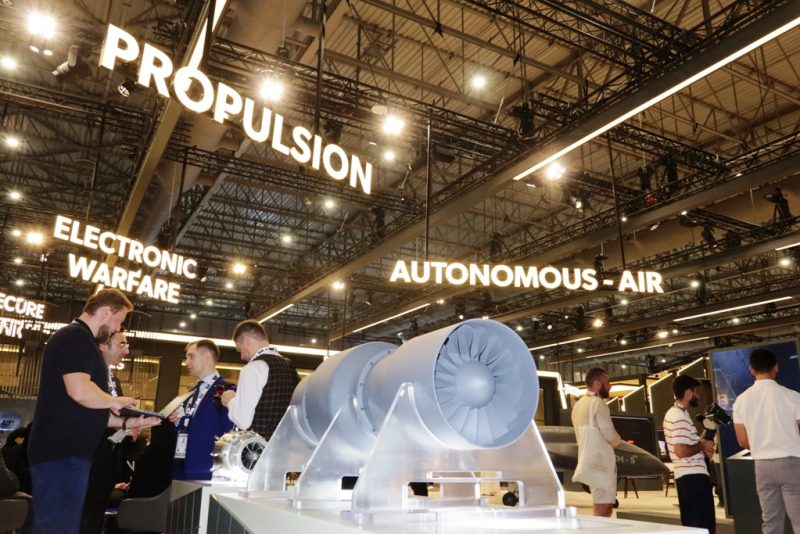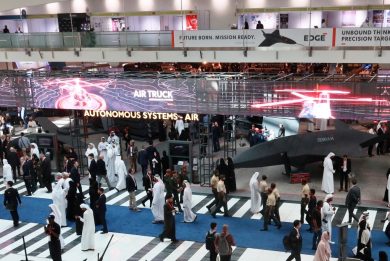Dubai Airshow 2025 – EDGE Powertech portfolio adds five new products to the engine unveiled at IDEX
Officially unveiled at IDEX 2025, the new EDGE entity dedicated to propulsion, Powertech, showcased at the Dubai event two new piston engines, two turbojets and a turbofan, that will soon start powering company UAVs and missiles
While work started in late 2023, Powertech was officially founded only in February 2025, when at IDEX 2025, it unveiled its P145i Piston Engine six-cylinder piston engine providing 145 hp. Nine months later the company portfolio increased dramatically, the EDGE group engine producer showing five new products under development, two smaller piston engines, two turbojets and one turbofan.
EDGE decided to create this new entity, as propulsion was considered an element of strategic significance in terms of sovereign capability. “We started with a handful of people, we are now around 50 and we will increase to 70 by year end,” Marian Lubieniecki, Powertech Chief Executive Officer told EDR On-Line in his stand at the Dubai Airshow.
One of the key targets set by the market was speed in development and in production. “We need to move much quicker because the market is quicker. Today we see a lot of potential application for our engines but if we don’t move quickly enough, we will miss the opportunity,” he explained.
Accelerating the development process is not only a matter of hardware. “The big power he of Emirates or is its capacity to access to global talent pool, and that allows really a big acceleration because we can pull the talent from different places,” he stated, adding that the company culture is at the base of that process, agility being key to find a way to do things quicker and at lower cost.
Initially most people were dealing with research and development, “but as we go much quicker than old fashioned companies from development to production to sales phases, time to market being the king, as products are being ready to be produced and sold, we are now adding production people and sales people.”
With the manpower strength mentioned before, Powertech cannot setup major production lines. “We like to be a product company, which means we develop the product, we own the product, we assembly it and we service it. But we decided strategically, at least in very initial phase to outsource the manufacturing of most of the parts, because after all we like to build engines, not the parts,” a path that is being followed by many defence companies.
This is also the reason why Powertech heavily investing on additive manufacturing. “We are considering additive manufacturing not only for prototyping, but also for serial production, I have about 10 years experience with that technology, I am perfectly convinced of that, and at the beginning of 2025 we acquired great talents to develop this,” the CEO explained, adding that his company is already printing some components, with the mindset of going to the serial production with them.
As said, the first product unveiled in early 2025 was an internal combustion piston engine, the P145i Piston Engine. This six-cylinder engine shares a lot of common characteristics with the two smaller ones, respectively known as P80i and P10i, all being two-stroke air-cooled engines featuring a double fuel pump fuel system. The bigger one provides 145 hp, a 1,800 cm3 displacement, and a 1,000 hours MBTO. It is 980 mm long, 610 mm wide and 720 mm high, and has a mass of less than 60 kg including all ancillaries, the 5 kW generator and the propeller. A key element is that while usually two-stroke engine run pre-mix fuel-oil, the P145i has separated oil and fuel tanks, which allows optimising oil consumption and lubrication, thus reducing oil on board, while also improving combustion efficiency, avoiding issues with injectors, and also bringing to mass reduction. The engine is also equipped with a monolithic crankshaft. Being the first of a family, its development lasted around 18 months and it is now running on the test bench, while the smaller engines, respectively a four- and a two-cylinder, were developed in only 8 months.
The P80i is derived from the bigger engine and maintains most of its characteristics. A 1,250 cm3 four-piston engine which mass is around 32 kg with ancillaries, 5 kW generator but without propeller. It is 470 mm long, 545 mm wide and 456 mm tall, and is in the final stage of development.
The smaller member of the family, the P10i, is a two-cylinder engine providing an output of 10-12 hp for a less than 6 kg mass, EDR On-Line understanding this is running on pre-mix fuel. Its generator provides 1 kW of exportable power, the engine being 300 mm long, 400 mm wide and 240 mm high. Both the P80i and the P10i are in the final development stage and should be available soon, EDR On-Line understood. The latter are mostly aimed at small drones and loitering munitions, an EDGE source told us, while the bigger engine will be used on larger fixed-wing UAVs. Interestingly, these engines are not produced in the UAE, EDGE having invested in a newly build facility located close to Como, in northern Italy.
Powertech is mostly looking at unmanned applications, and the size and output of its engines will remain in the current range, further developments being market driven, EDR On-Line was told.
Shifting to jet engines, here we find two turbojets, the PJ120 and the PJ40, numbers being the thrust in kg. These have been in development since the company infancy, and are now being unveiled as they become closer to the end of development. Powertech is planning to start low rate production in Q3/26; the PJ40 has already been on the test bench and the company is busy preparing the pre-production item, while the PJ120 is currently at prototype level and is running on the test bench, EDR On-Line was told, understanding that the item shown at the exhibition was the real one, which will be back on the bench as soon as the Dubai Airshow will close.
The PJ40 has a maximum continuous thrust of 450 N at sea level, with a maximum thrust overspeed of 580 N. It is 390 mm long, has a 155 mm diameter and a mass of 6 kg, its thrust specific fuel consumption at nominal thrust being under 40 g/kN.s
The bigger PJ120 has a 1,200 N maximum continuous thrust at sea level. Length and diameter increase respectively to 600 and 232 mm, mass becomes 20 kg, while the engine is more efficient, its fuel consumption being less than 34 g/KN.s. Both will be used for powering UAVs and missiles.
The third line of products is that of turbofans, the single product of that category currently in the development phase being the X550, a much bigger engine considering its thrust, which is 1,200 mm long, with a 360 mm diameter, for a 105 kg mass. Maximum continuous thrust at sea level is 4,700 N, with a maximum thrust overspeed of 5,000 N, both data at sea level, fuel consumption at nominal thrust being under 22 g/KN.s, turbofans being inherently less fuel thirsty than turbojets. “The X550 is our step towards more complicated technologies, a turbofan engine having different complexity,” Marian Lubieniecki told EDR On-Line, adding that this step can be achieved in the planned timeframe, Powertech planning to have it running on the test bench in early 2027. The CEO let us understand that some slightly bigger turbofans might well be developed in the future, to cope with some needs for the propulsion of new missile developments.
EDGE aims at being disruptive also on the cost side, however talking to Powertech representatives they made clear that while this aspect is of course being considered, there will be no compromise in terms of quality, the aim being 100% reliability, therefore company products cost might be comparable to that of some low cost solutions proposed by some countries, but they will be fully qualified, performances, quality and reliability being the key development issues.
“Powertech is looking at unmanned application, either drones or missiles, so we will go where this market will go, and we think we designed our engines to have solid business, our being really a market-driven story, the company CEO concluded, adding that Powertech is one of the very few companies capable to offer both piston and jet engines for unmanned platforms.
Photos by P. Valpolini











